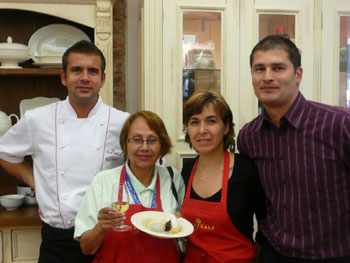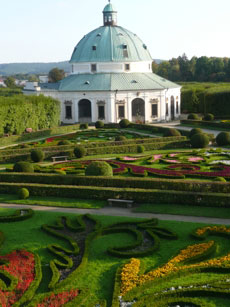I joined a group of 20 at the Prazky Kulinarsky Institut(Prague Culinary Institute) where Co-owner Roman Vanek, Chefs Vaclav Fric, David Izak and Apprentice Barbara Simunkova taught us how to cook with wine and plum brandy, and sometimes, we did put it in the food! The Prague Culinary Institute, began in 2008, and offers a huge range of courses for the general public, professionals and personal chefs for diplomats etc.

Radek Kasparek, Lenora Hayman, Valentina Dzombakova, Martin Schwarz at Ola Kala Culinary School
We created a crème soup with a lost egg. After cracking an egg, it was dropped into potato vinegar causing the white to surround the yolk which was then lightly boiled and dropped into cold water to stop further cooking. The yolk was nicely lost inside its white cover. On gently cutting the egg on top of the soup, the yellow yolk drizzled over the soup. We also helped to prepare sirloin of beef with Karlsbad dumplings and roasted duck with red cabbage and potato dumplings. Dumplings in all their varieties are popular. The food is not light but rich with cream and delicious.
The following morning, 6 friends and I, headed for Michal Nikodem’s Ola Kala Culinary School. Martin Schwarz, the sommelier, paired our wines. Chef Radek Kasparak guided us in the cooking of a moist pheasant with fresh nettle and shallot gravy and Valentina Dzombakova spoiled us by constantly washing our utensils. We stuffed plums with chocolate mousse and made a sweet dumpling to accompany our personally churned poppy seed ice-cream topped with Slivovice plum brandy sauce.
Now that I had proved to my friends, that I could cook as well as eat, I took a 2 day tour south to Moravia. Traveling, on the SuperCity Pendolino train, 250 kms from Prague, took only 2 hours, to begin our walking-tour of Olomouc, the cultural capital of Moravia, on the confluence of the Moravia and Bystrice rivers. Olomouc is the home of the Palacky University.
The Neo-Gothic St. Wenceslas (Vaclava) Cathedral on Wenceslas Square has the 2nd highest church tower in the Czech Republic. Next door is the Presbytery where in 1767 Wolfgang Amadeus Mozart (1756-1791) lived, after fleeing Vienna, due to a small pox epidemic
A plaque honours Mozart, who as an 11 year old in Olomouc composed the 6th symphony in F Major!
In 2001, the 35 metre high Baroque Holy Trinity Column (1716-1754), in the main square, became a UNESCO World Heritage site and was completed, 20 years after its local architect/stonemason and sponsor Vaclav Render died. The Archangel Michael with sword and shield, the dove representing the Holy Spirit and God the Father and Christ with a cross sitting on a globe, grace the pinnacle of the column.
The Astronomical Clock on the Olomouc town hall dates back to the 15th century. During the years of communism, it was updated with a dial display of the birthdays of Lenin and Stalin. An astronomical clock displays not only the hour and minutes, but the day of the week, month and phase of the moon and stars, the 4 seasons and signs of the zodiac. The communist vacations are highlighted in red, including in 1953, the deaths of Stalin and 2 weeks later Klement Gottwala the first Communist President of Czechoslovakia.
The Arion Fountain (2002) in the upper square depicts the story of a Greek poet being saved by a dolphin from drowning. It completes the set of 7 Olomouc Baroque fountains.
Our lunch, of cabbage soup and pork with rosehip sauce and apple dumpling was on the main square at the Moravska restaurant, beautifully decorated with dried flowers and painted vases.
Forty-five kms S.E. of Olomouc is Kromeriz and the Kromeriz Archiepiscopal Chateau and Kromeriz Gardens, listed since 1998, as UNESCO World Natural and Cultural Heritage sites.

Kromeriz UNESCO Flower Gardens & Rotunda
The Kromeriz Chateau, built in 1110, was from 1646-1947, the summer home of the Olomouc bishops. Photos are prohibited inside the archiepiscopal castle on whose walls hang breathtaking European 15-18th century paintings by Tizian, Jan Breughel etc. The film Amadeus had a scene in the room with 22 chandeliers.
The Kromeriz Gardens, encompass 64 hectares, and include 3 lakes, a pendulum in the octagonal rotunda with lovely murals, Pompeian and Colloredo Colonnades lined with Greek statues and magnificent, sculptured, baroque, flower gardens.
I spent a wonderful and interesting night in the Kromeriz Octarna Hotel and Restaurant. Formerly a Franciscan Monastery, the rooms are luxuriously furnished without loosing their former ambiance. The monks would have loved the modern, heated swimming pool, sauna and spa treatments. Their historical Max Svabinsky hall with warm, red furnishings and portraits of monks looking benevolently over us was the setting for the gala evening featuring local food paired with Moravian wine, served by Restaurant Manager Vladimir Valouch and his knowledgeable staff. The Marecek Dulcimer group entertained us while dining on smoked beef tongue with horseradish sauce and grilled caraway bread, beef broth with liver dumplings, and pork accompanied with Znovin Znojmo wines. Their sauvignon blancs are reminiscent of those in New Zealand with peach, grass and nettle overtones. The sweet, late harvest Palava, a crossbreed of Muller-Thurgau and spicy Traminer is intensely aromatic with hints of grapefruit and lemon.
The next morning we visited the Olomoucke Tvarusky museum in Lostice to learn how the founder Alois Wessels, in 1876, made genuine Olomouc cakes of cheese. They are semi-soft, without fat, in 6 different shapes and “prepared according to the 120 recipes in the Cookery Book of Unusual Scent”! Great cheeses! No wonder their store was crowded!
When you go: Czech Tourism Website. www.czechtourism.com